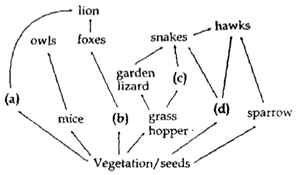Identify the possible link "A" in the following food chain :
Plant → insect - frog → "A" → Eagle
1. Rabbit
2. WoIf
3. Cobra
4. Parrot
Plant → insect - frog → "A" → Eagle
1. Rabbit
2. WoIf
3. Cobra
4. Parrot
Given below is an imaginary pyramid of numbers. What could be one of the possibilities about certain organisms at some of the different levels?
| 1. | Level PC is "insects" and level SC is "small insectivorous birds". |
| 2. | Level PP is "phytoplanktons" in sea and "Whale" on top level TC |
| 3. | Level PP is "pipal trees" and level SC is "sheep". |
| 4. | Level PC is "rats" and level SC is "cats". |
Which one of the following is not a functional unit of an ecosystem
1. Energy flow
2. Decomposition
3. Productivity
4. Stratification

To unlock all the explanations of 38 chapters you need to be enrolled in MasterClass Course.

To unlock all the explanations of 38 chapters you need to be enrolled in MasterClass Course.
The upright pyramid of number is absent in
1. Pond
2. Forest
3. Lake
4. Grassland
Identify the likely organisms (a), (b), (c) and (d) in the food web shown below:

Options
|
(a) |
(b) |
(c) |
(d) |
|
|
1. |
deer |
rabbit |
frog |
rat |
|
2. |
dog |
squirrel |
bat |
deer |
|
3. |
rat |
dog |
tortoise |
crow |
|
4. |
squirrel |
cat |
rat |
pigeon |
The rate of formation of new organic matter by rabbits in grassland is called:
1. Net productivity
2. Secondary productivity
3. Net primary productivity
4. Gross primary productivity

To unlock all the explanations of 38 chapters you need to be enrolled in MasterClass Course.

To unlock all the explanations of 38 chapters you need to be enrolled in MasterClass Course.
The second stage of hydrosere is occupied by plants like :
1. Azolla
2.Typha
3.Salix
4. Vallisneria
Natural reservoir of phosphorus is :
1. Animal bones
2. Rock
3. Fossils
4.Sea water

To unlock all the explanations of 38 chapters you need to be enrolled in MasterClass Course.

To unlock all the explanations of 38 chapters you need to be enrolled in MasterClass Course.
Secondary productivity is rate of formation of new organic matter by:
1. Parasite
2. Consumer
3. Decomposer
4. Producer

To unlock all the explanations of 38 chapters you need to be enrolled in MasterClass Course.

To unlock all the explanations of 38 chapters you need to be enrolled in MasterClass Course.
If 20 J of energy is trapped at producer level, then how much energy will be available to peacock as food in the following chain?
plant → mice → snake → peacock
1. 0.02 J
2. 0.002 J
3. 0.2 J
4. 0.0002 J

To unlock all the explanations of 38 chapters you need to be enrolled in MasterClass Course.

To unlock all the explanations of 38 chapters you need to be enrolled in MasterClass Course.







